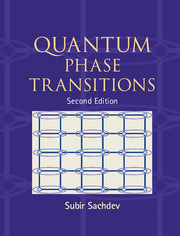Book contents
- Frontmatter
- Contents
- From the Preface to the first edition
- Preface to the second edition
- Part I Introduction
- Part II A first course
- 3 Classical phase transitions
- 4 The renormalization group
- 5 The quantum Ising model
- 6 The quantum rotor model
- 7 Correlations, susceptibilities, and the quantum critical point
- 8 Broken symmetries
- 9 Boson Hubbard model
- Part III Nonzero temperatures
- Part IV Other models
- References
- Index
7 - Correlations, susceptibilities, and the quantum critical point
from Part II - A first course
Published online by Cambridge University Press: 16 May 2011
- Frontmatter
- Contents
- From the Preface to the first edition
- Preface to the second edition
- Part I Introduction
- Part II A first course
- 3 Classical phase transitions
- 4 The renormalization group
- 5 The quantum Ising model
- 6 The quantum rotor model
- 7 Correlations, susceptibilities, and the quantum critical point
- 8 Broken symmetries
- 9 Boson Hubbard model
- Part III Nonzero temperatures
- Part IV Other models
- References
- Index
Summary
We have so far described our quantum phases and critical points in terms of the wave-functions and energies of the eigenstates of the Hamiltonian. However, as we saw in our treatment of D-dimensional classical statistical mechanics in Chapters 3 and 4, a more subtle and complete characterization is obtained by considering correlation functions of various observable operators. These correlation functions are also amenable to a Feynman graph expansion and the renormalization group transformation, which was crucial in our full treatment of the classical critical point. This chapter considers correlation functions of the d-dimensional quantum model, and applies them to obtain an improved understanding of the quantum phases and the quantum critical point.
Section 5.5.3 has already presented a detailed description of the connection between the correlation functions of the D = 1 classical Ising chain and the single-site (i.e. d = 0) quantum Ising model. This mapping is immediately extended to the general D case, following the reasoning in Sections 5.6 and 6.5. From this we obtain the fundamental result that the two-point correlation function, C, of φα in (3.39) of the D-dimensional classical field theory (2.11) is precisely the same as the time-ordered correlation function of the operator φα under the Hamiltonian ℋ in (6.52).
Information
- Type
- Chapter
- Information
- Quantum Phase Transitions , pp. 96 - 107Publisher: Cambridge University PressPrint publication year: 2011
